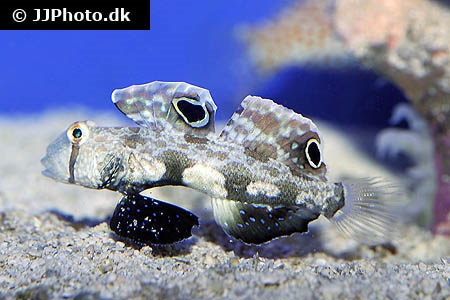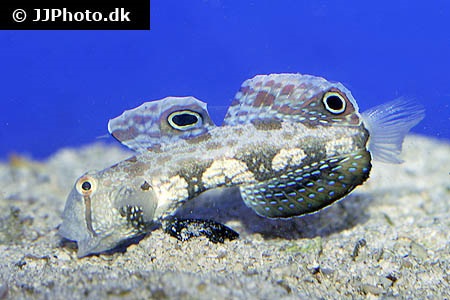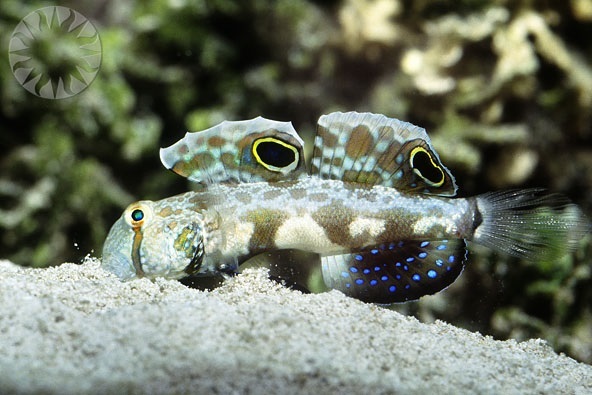Signigobius biocellatus
| Latin name | Signigobius biocellatus - Hoese & Allen, 1977 |
|---|---|
| Local name | Twinspot goby |
| Family | Gobiidae - Signigobius |
| Origin | Australia, Indonesia, Central/West Pacific |
| Max length | 10 cm (3.9") |
| Minimum volume |
150 l (40 gal) |
|---|---|
| Hardiness |
Average |
| Suitable for aquarium |
Experience, preparation and extra care required |
| Reef safe |
Always reef safe |
| Aggressiveness | Mostly peaceful but might be aggressive towards similar species |
| Recommended |
Small crustaceans (Krill, mysis, artemia...) Zooplankton (Cyclops, pods...) |
|---|
This species can be kept in a small tank, if it is specifically equipped to meet its needs.
It is recommended however, to keep it in an aquarium which is larger then described above.
This species must be fed with an appropriately varied diet.
This species thrives best when there is a sufficiently large amount of micro life (copepods, amphipods or similar) in the aquarium, so that the it can always find their own food.
This fish requires feeding several times a day, especially when newly added.
When the fish can find its natural food in the aquarium it requires less frequent feeding.
They can live as a pair provided they are introduced simultaneously.
This species can be bred in captivity, one can therefore consider asking your local fish store for a captive bred specimen.
These fish can be difficult to feed, as they eats only from the sand. It will be hard for them to find enough food in a small aquarium, so one must feed them three times daily by squirting food into the sand.
Gobies (Gobiidae) are generally small fish, which live close to the bottom. Many of the species are fairly hardy and well suited to aquaria. The behaviour of the different kinds of Gobies varies greatly and some can be very interesting.
The most common types of Gobies in aquaria are the following:
Sand eating Gobies (Amblygobius, Koumansetta and Valenciennea)
Sand eaters filter the sand through their mouths and out of their gills.
They are generally bigger than other Gobies, but they are usually peaceful, so size is not a problem.. They can however be aggressive towards their own species.
One must be aware that they can eradicate the micro life in the substrate when the tank is too small. If there is not enough live food in the sand, it can be difficult to ensure the fish stay in good condition, as they require frequent feeding.
They may spread sand across the corals when they eat.
Shrimp Gobies (Amblyeleotris, Cryptocentrus and Stonogbiops)
Shrimp Gobies have a symbiotic relationship with Pistol shrimps, but one must first find out which species can live together.
The shrimp and Goby live together in a small hole in the sand or under a stone where the shrimp maintains the hole, so it will not collapse over time. The Goby helps by looking out for enemies, since the shrimp does not see well in sunlight, as it will have become accustomed its vision to the darkness of the hole.
Neon Gobies (Elacatinus/Gobiosoma)
Thesef Gobies are very small and like the Cleaner Wrasse, it eats parasites off other fish.
These Gobies are easier to keep alive in the aquarium than Cleaner Wrasses, as they can eat a wide range of foods.
Clown Gobies (Gobiodon)
These fish are very small and therefore suitable for small aquariums. Clown Gobies will often hide inbetween the branches of stony corals, like Acropora for example.
They generally eat many types of food, as long as it is small enough.
| Aquarium trade | Yes |
|---|---|
| Distribution | Western Pacific: Philippines to the Solomon Islands and Vanuatu, south to the southern Great Barrier Reef; Palau in Micronesia. |
| Danish common names |
Signalkutling |
| English common names |
Twinspot goby Crab-eyed goby Crab-eye goby Four-eyed gobby |
Scott W. Michael. Reef Aquarium Fishes: 500+ Essential-to-know Species - TFH Publications / Microcosm Ltd. - (English)
James W. Fatherree. 2011. Aquarium Fish: A Look at the Gobies - Advanced Aquarist - (English)
Bob Fenner. "True" or Combtooth Gobies, the Family Gobiidae - Wet Web Media - (English)




